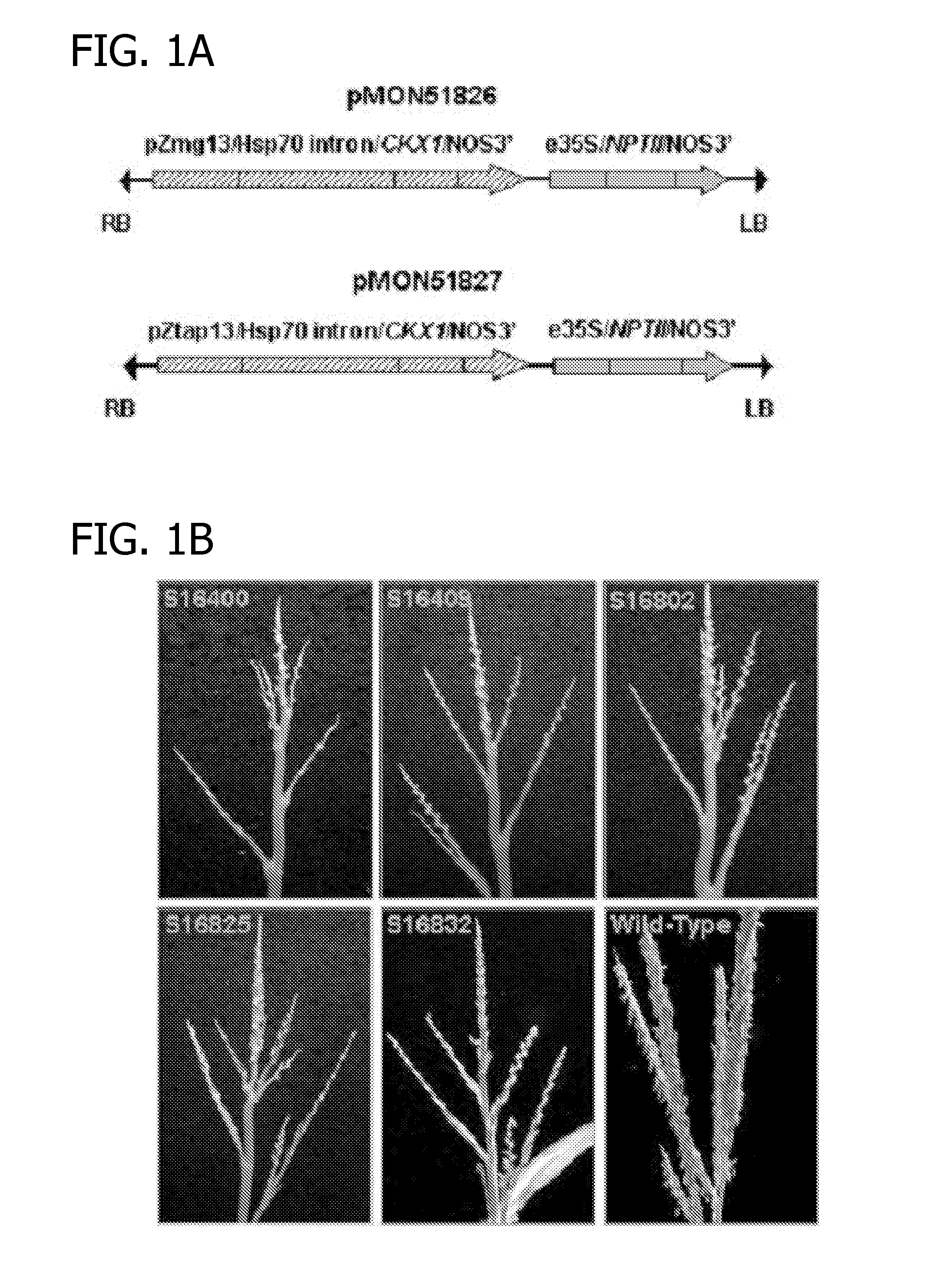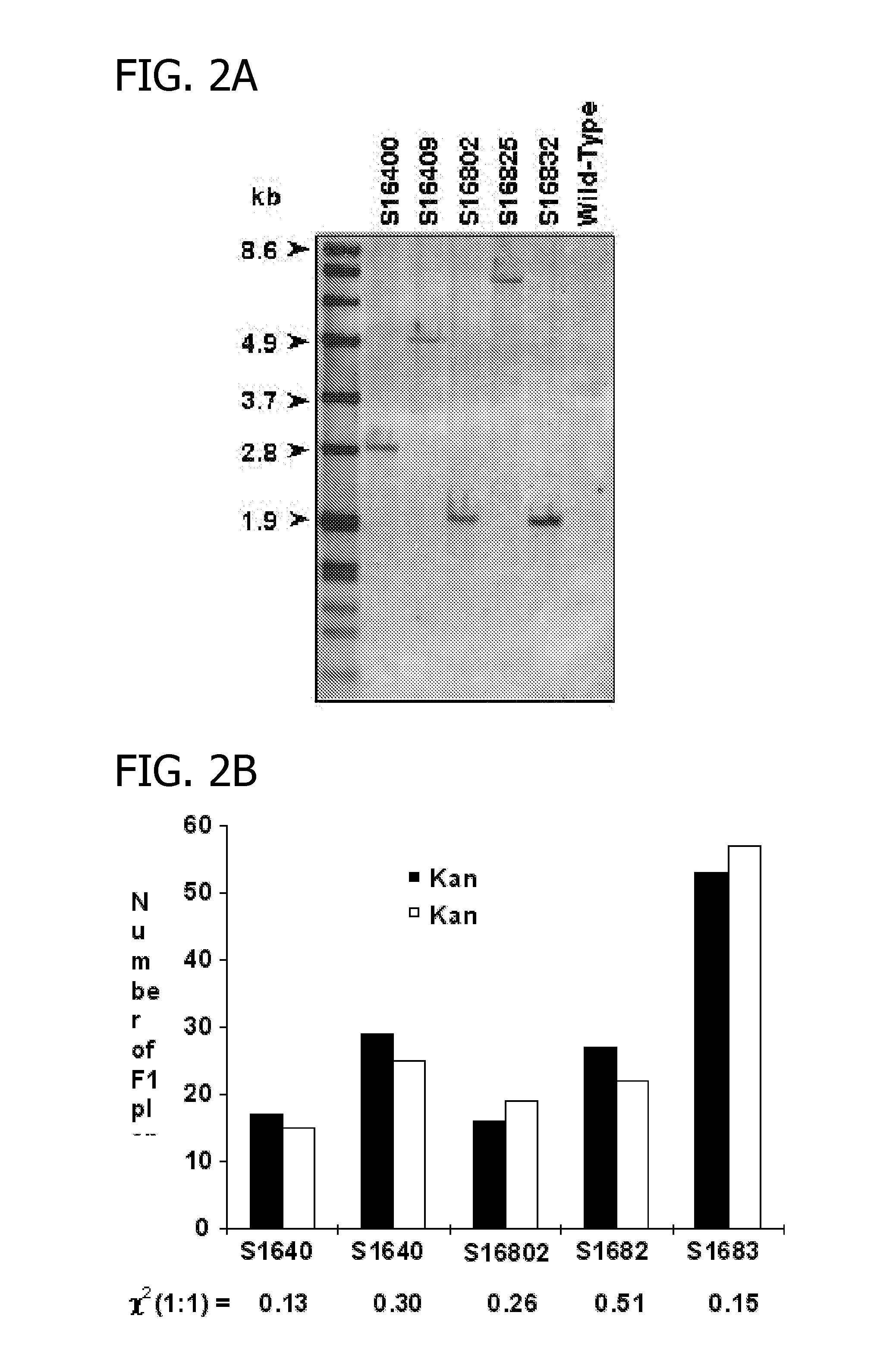Reversible male sterility in transgenic plants by expression of cytokinin oxidase
a technology of cytokinin oxidase and transgenic plants, which is applied in the field of reversible male sterility in transgenic plants, can solve the problems of low yield of treated plants, impractical commercial hybrid seed production, and hormonal induction of male sterility, so as to reduce the expression or activity of cytokinin oxidase, and restore male sterility
- Summary
- Abstract
- Description
- Claims
- Application Information
AI Technical Summary
Benefits of technology
Problems solved by technology
Method used
Image
Examples
example 1
Vector Construction
[0067]The complete 1.7-kb corn cytokinin oxidase (CKX1)-containing DNA fragment including the transit peptide was inserted into expression cassettes driven by either the pollen-specific pZmg13 promoter (Hanson et al., Plant Cell, 1:173-179, 1989) or the anther-specific pZtap promoter (PCT Publ. No. WO 99 / 46396), and terminated by the nopline synthase sequence (NOS3′). These cassettes also included an intron from a heat shock protein (HSP70 intron) to increase the expression of CKX1. The resulting CKX1 expression cassettes were cloned into binary vectors using an enhanced CaMV 35S promoter (e35S)-driving NPTII as the selectable marker to generate pMON51826 and pMON51827 (FIG. 1A). All other genetic elements used in the binary vector were identical to those described by Ye et al (Plant J., 19:249-257, 1999).
example 2
Transformation, Plant Material and Growth Conditions
[0068]The binary vectors, pMON51826 and pMON51827 were electroporated into Agrobacterium tumefaciens ABI strain and introduced into corn embryos (LH198 X HiII) by Agrobacterium-mediated transformation. H99 pollen was used to pollinate R0 male sterile transgenic plants to produce F1 seeds. All of the plants were grown in greenhouses at 28 / 21° C. (day / night) with a 16-hr photoperiod (400 mmol m−2 sec−1), and 50% relative humidity.
[0069]Thirty-three and 31 independent RO transgenic plants were generated harboring pMON51826 and pMON51827, respectively. Despite the difference in the promoters, 29 plants each of pMON51826 and pMON51827 displayed a similar complete, sporophytic male sterile phenotype. At the apex of the plants where the tassels ordinarily form, the male sterile transgenic plants produced rudimentary terminal structures that lacked recognizable male florets or spikelets (FIG. 1B). These transgenic plants were also shorter ...
example 3
Plant DNA Isolation and F1 Segregation Analysis
[0070]Five independent lines were selected for genomic DNA analysis (FIG. 2A). Genomic DNA was isolated from leaves of corn plants using the DNeasy Plant Mini Kit (Qiagen, Valencia, Calif.). Genomic DNA (20 mg) was digested with restriction enzymes (BamHI), separated on a 0.8% (w / v) agarose gel, and transferred to positively charged nylon membranes (Roche Molecular Biochemicals, Indianapolis, Ind.). Prehybridization, hybridization, washing and detection of the membranes were conducted using the non-radioactive DIG system (Roche Molecular Biochemicals) following the manufacturer's protocols.
[0071]The presence of NPTII in the F1 plants was determined by both antibiotic resistance and the NPTII ELISA from leaf protein extracts. An antibiotic solution containing 1 g / L kanamycin, 1 g / L paromomycin and 0.6% (v / v) Silwet L77 surfactant (Loveland, Greenley, Colo.), was applied to plants at V2 or V3 stages. Three days after application, the kana...
PUM
| Property | Measurement | Unit |
|---|---|---|
| temperature | aaaaa | aaaaa |
| temperature | aaaaa | aaaaa |
| frequency | aaaaa | aaaaa |
Abstract
Description
Claims
Application Information
 Login to View More
Login to View More - R&D
- Intellectual Property
- Life Sciences
- Materials
- Tech Scout
- Unparalleled Data Quality
- Higher Quality Content
- 60% Fewer Hallucinations
Browse by: Latest US Patents, China's latest patents, Technical Efficacy Thesaurus, Application Domain, Technology Topic, Popular Technical Reports.
© 2025 PatSnap. All rights reserved.Legal|Privacy policy|Modern Slavery Act Transparency Statement|Sitemap|About US| Contact US: help@patsnap.com



